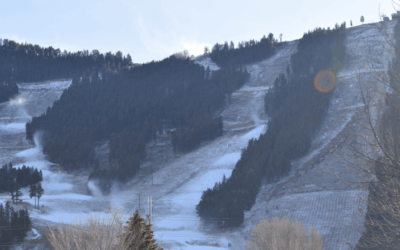This story comes through a content-sharing partnership with Wyoming Public Media.
Twenty years ago, two huge wind driven fires engulfed the forests along Yellowstone National Park’s eastern corridor.
Yellowstone Lake laps at its eastern shore in Mary Bay. This is the land of bears, and burns. It is the park’s innermost border of the East Fire, which started with a lightning strike near Cub Creek.
It happened late at night, August 11, 2003. By the time it was out, the fire had burned 17,000 acres from the top of Sylvan Pass to the Pelican Valley Trailhead. No one was hurt, and it spared buildings at Fishing Bridge, but destroyed several cars parked near Yellowstone Lake.
Wyoming Public Radio reporter Penny Preston was there that night when the East fire started. She was driving back from Grand Teton National Park and stopped at the Cub Creek curve. She parked on the road next to a truck, whose occupants were also mesmerized at the sight.
She said it was breathtaking to witness the power of a wildfire in Yellowstone National Park. Trees were exploding from the intense fire. There was nothing anyone could do to stop it.
Yellowstone’s Fire ecologist, Rebecca Smith recalled, “I was here in 2003 as a seasonal fire effects crewmember. I remember when the call came in for the initial fire size-up, and we had someone up in the helicopter flying over the area where the East Fire started. And, by the time they got the helicopter from Mammoth to East Entrance, it was already a running crown fire, which is not something we can readily stop in fire, no matter what resources we use.”
There was another fire burning nearby that hot August: the Grizzly Fire, which scorched nearly 4,100 acres north of Yellowstone Lake. The Park’s East Entrance was closed August 13, for hundreds of firefighters to work to contain the East and Grizzly fires.
If you drive up to a parking area, called Lake Butte Overlook today, there are dead standing trees as far as the eye can see.
Creston Bruun from Denmark studied the sight, “When I look at the area and I see how the new trees have come up, they might look like being six or ten years old. The old burned trees, they are blown down by the wind, so uh, they have got rotten so that also must be some years. So, my guess would be six to ten years.”
Bruun was surprised to learn this was a 20 year old burn.
Smith said this part of the park is different from the parts that were burned in the 1988 wildfires, which were mostly dominated by lodgepole pine. Those areas have regrown much more quickly, tall pines changing the burn into a forest again.
She said this East burn area had a mixed forest of spruce, fir, and some lodgepole pine. So, people in the cars that are passing by see more lake views and almost bare hilltops, because it takes a long time for spruce and fir to grow back. Some areas have smaller lodgepole pines among the dead trunks.
Smith pointed out, “We are seeing a lot of ground vegetation coming in like grasses, fireweed, lupine.”
That’s where the bears come in. Tourists seem to be seeing more grizzlies in this part of the park, in the last 20 years.
Penny Preston’s husband chopped wood to keep warm this August, because the temperatures drop down into the 40’s at night in the Shoshone Forest, east of Yellowstone. It’s been a cool, wet summer. Dr. Charles Preston is the founding curator of the Draper Natural History Museum in Cody, and a wildlife ecologist.
“I think the grizzly bear population is pretty healthy along here on the East side of Yellowstone, particularly,” said Preston.
He’s watched the evolution of the forest, and its inhabitants inside the East and Grizzly burn scars.
“Wildfires are actually beneficial to the grizzly bears,” he said. “The fires open up the canopy, and they provide new nutrients to the soil, which supports really lush vegetation. And, that’s the mainstay for the grizzly bear diet for much of the year.”
Now the Yellowstone visitor who is passing by the dead and fallen trees often stops to join the bear jams. Preston said those bear jams have been very common here.
“Grizzly bears are also much more obvious to the passersby as they drive by some of these areas that have been burned. Because the timber now is gone, they have a much better view of grizzly bears from the road,” he said.
So the passerby who doesn’t know, or remember when the East fire scorched 16 miles of forest along the road to Fishing Bridge, this is the land of burns, and bears.






